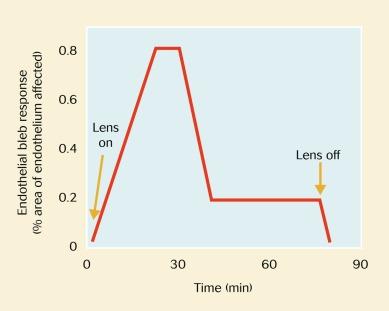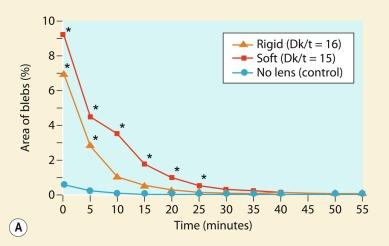Physical Address
304 North Cardinal St.
Dorchester Center, MA 02124
Before 1977, it was thought that contact lenses could only affect the cornea by direct mechanical influence or oxygen deprivation. Because the endothelium is located on the posterior surface of the cornea and is known to obtain all of its required oxygen from that dissolved in the aqueous humor, this tissue layer was thought to be immune to the effects of contact lenses.
The first clue that contact lenses could alter corneal endothelium came from Zantos and Holden, who noted that the endothelial mosaic undergoes a dramatic alteration in appearance within minutes of inserting a contact lens. Specifically, they reported observing a number of black, non-reflecting areas in the endothelial mosaic – which they called blebs – and an apparent increase in the separation between cells. These changes can be observed under high magnification (× 40) using the slit lamp biomicroscope ( Fig. 30.1 ).
The contact lens fraternity remained sceptical for some time, and it was not until (a) the appearance of blebs was verified independently and (b) reports of contact lens–induced endothelial polymegethism were published by Schoessler and Woloschak, in the early 1980s, that serious research commenced into understanding the endothelial response to lens wear.
The prevalence of endothelial blebs is thought to be essentially 100% among contact lens wearers ; that is, blebs can be observed in all patients – even those wearing highly oxygen transmissible lenses – within 10 minutes of lens insertion. There is a large variation in the intensity of the response between lens types and patients. Asian subjects have a significantly higher degree of endothelial bleb formation compared with the non-Asian population for closed-eye lens wear.
The black, non-reflecting areas observed in the endothelial mosaic correspond to the position of individual cells or groups of cells. The initial impression one gains is that cells have ‘fallen off’ the posterior surface of the cornea, leaving behind gaps or black holes. In corneas displaying a marked blebbing response, it also appears as if all endothelial cells throughout the field of view have become more separated and the endothelial surface takes on a more textured and three-dimensional appearance.
The ‘bleb response’ displays a characteristic time course ( Fig. 30.2 ). Blebs can be observed within 10 minutes of lens insertion. The number of blebs peaks in 20 to 30 minutes and then subsides to a low level after about 45 to 60 minutes. A low-level bleb response can be observed throughout the remainder of the wearing period.

Hydrogel lenses cause a greater bleb response compared with well-fitting rigid lenses. Lenses of greater average thickness induce a greater response compared with thinner lenses. However, the design and fit of hydrogel lenses have little effect on the bleb response. Ohya et al. observed that blebs are confined to the central regions of the cornea beneath rigid lenses but that they occur throughout the cornea with soft lenses; that is, blebs are seen in all corneal areas covered by contact lenses.
Williams and Holden observed two additional endothelial phenomena in patients wearing soft lenses on an extended-wear basis. First, there appears to be an increase in the number of blebs in the late evening, before going to sleep. Second, the overall magnitude of the bleb response can be seen to decrease over the initial 8 days of extended wear. Furthermore, Bruce and Brennan noted that the overall bleb response was reduced by approximately 50% after 4 months of soft lens extended wear compared with baseline values. These observations suggest that some form of short-term and long-term adaptation of the endothelium takes place.
Brennan et al. evaluated the corneal endothelial bleb response to wear of silicone hydrogel lenses (Acuvue Oaysis, Acuvue Advance and Focus Night & Day) and a conventional hydrogel lens (SofLens 38) in eyes of East Asian subjects. SofLens 38 produced a mean percentage area of blebs of 8% under closed-eye conditions, which was significantly greater than that produced by Acuvue Oaysis (1.6%). Both Acuvue Advance and Focus Night & Day produced a mean percentage bleb area of 0.4% under open-eye conditions. Acuvue Oaysis and Focus Night & Day produced statistically similar mean percentage bleb areas of 1.7% and 2%, respectively. The authors concluded that the similarity of the bleb responses induced by the silicone-hydrogel lenses under the tested wearing conditions is consistent with the proposition that increases in oxygen transmissibility (Dk/t) above a certain level will produce minimal change in corneal physiological conditions compared with that when no lens is worn.
Inagaki et al. compared the time course of endothelial bleb formation and disappearance between contact lenses of low Dk/t (rigid 16, soft 15), medium Dk/t (rigid 49, soft 49) and high Dk/t (rigid 181, soft 175). Twenty subjects kept their eyes closed for 20 minutes after putting on each test lens. Starting just after eye opening, the eyes were examined for blebs every 5 minutes by specular microscopy, and the percentage area of the blebs was calculated. As controls, the same eyes were also examined without contact lens wear. The percentage area of the blebs just after eye opening and during a 55-minute ‘recovery’ period are shown in Figures 30.3 A, B and C for low-, medium- and high-Dk/t lenses, respectively. No difference was observed between rigid and soft lenses of similar Dk/t values in the medium and high categories. However, for low-Dk/t lenses, rigid lenses appear to have a lower effect on the corneal endothelium compared with soft lenses.

Despite their stunning clinical appearance, blebs are asymptomatic and thought to be of little clinical significance. They are, however, of great interest to physiologists who are endeavouring to understand the workings of the cornea.
Become a Clinical Tree membership for Full access and enjoy Unlimited articles
If you are a member. Log in here